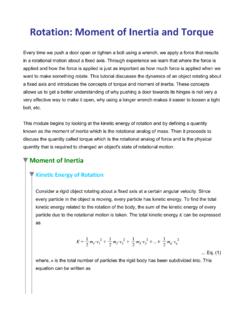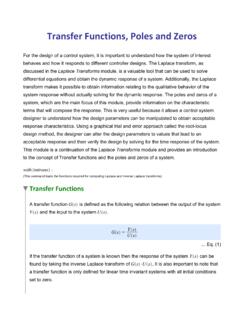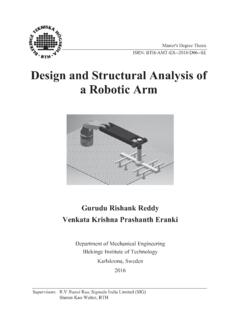Transcription of Robot Manipulators - Waterloo Maple
1 Robot Manipulators Position, Orientation and Coordinate TransformationsFig. 1: Programmable Universal Manipulator Arm (PUMA)A Robot manipulator is an electronically controlled mechanism, consisting of multiple segments,that performs tasks by interacting with its environment. They are also commonly referred to as robotic arms. Robot Manipulators are extensively used in the industrial manufacturing sector and also have many other specialized applications (for example, the Canadarm was used on space shuttles to manipulate payloads). The study of Robot Manipulators involves dealing with the positions and orientations of the several segments that make up the Manipulators . This module introduces the basic concepts that are required to describe these positions and orientations of rigid bodies in space and perform coordinate transformations.
2 ManipulatorsManipulators are composed of an assembly of links and joints. Links are defined as the rigidsections that make up the mechanism and joints are defined as the connection between twolinks. The device attached to the manipulator which interacts with its environment to performtasks is called the end-effector. In Fig. 2, link 6 is the end 2: Links and jointsTypes of JointsJoints allow restricted relative motion between two links. The following table describes five types of joints. Table 1: Types of jointsName of jointRepresentationDescriptionRevoluteAl lows relative rotation about one axis. CylindricalAllows relative rotation and translation about one relative translation about one three degrees of rotational freedom about the center of the joint.
3 Also known as a ball-and-socket relative translation on a plane and relative rotation about an axis perpendicular to the plane. Some Classification of ManipulatorsManipulators can be classified according to a variety of criteria. The following are two of these criteria:By Motion CharacteristicsPlanar manipulator: A manipulator is called a planar manipulator if all the moving links move in planes parallel to one another. Spherical manipulator: A manipulator is called a spherical manipulator if all the links perform spherical motions about a common stationary manipulator: A manipulator is called a spatial manipulator if at least one of the links of the mechanism possesses a general spatial motion. By Kinematic StructureOpen-loop manipulator (or serial Robot ): A manipulator is called an open-loop manipulator if its links form an open-loop manipulator: A manipulator is called a parallel manipulator if it is made up ofa closed-loop manipulator: A manipulator is called a hybrid manipulator if it consists of open loop and closed loop of FreedomThe number of degrees of freedom of a mechanism are defined as the number of independent variables that are required to completely identify its configuration in space.
4 The number of degrees of freedom for a manipulator can be calculated as .. Eq. (1)where is the number of links (this includes the ground link), is the number of joints, is the number of degrees of freedom of the joint and is for planar mechanisms and for spatial mechanisms. Vector Kinematics and Coordinate TransformationsThis section covers the concepts required to specify the location of an object in space. This involves specifying the position of a point on the object and the orientation of the object with respect to a reference frame. Description of a PositionThe position of any point in space, relative to a reference frame, can be described by a 3x1 position vector. For example, the position of point P (see Fig. 3) with respect to frame A can be written asEq.
5 (2)where , and are the magnitudes of the projections of the line joining the point andthe origin on the and axes respectively. Fig. 3: Position vectorDescription of an OrientationThe orientation of a body in space can be described by attaching a coordinate system to it and then describing the vectors of its coordinate axes relative to a known frame of reference. For example, the coordinate axes of Frame B (see Fig. 4) can be described relative to a known coordinate system A by the following unit vectors:.. Eq. (3)These three vectors can be combined to achieve a 3x3 matrix called a rotation matrix.. Eq. (4)3. 3. 1. 1. 2. 2. Fig. 4: Components of the rotation matrix of Frame B Frame ARotation Matrix PropertiesAll the columns of a rotation matrix are orthogonal to each determinant of a rotation matrix is inverse of a rotation matrix is equal to its Eq.
6 (5)This means that the rotation matrix of Frame B with respect to Frame A is equal to theinverse and the transpose of the rotation matrix of Frame A with respect to Frame B. Principal Rotation MatricesRotation about the z-axisIf a reference frame (Frame A) is rotated by an angle about the z-axis to obtain a new frame (Frame B), the rotation matrix of the new frame Eq. (6)Fig. 5: Rotation about the z-axisRotation about the y-axisIf a reference frame (Frame A) is rotated by an angle about the y-axis to obtain a new frame (Frame B), the rotation matrix of the new frame Eq. (7)Fig. 6: Rotation about the y-axisRotation about the x-axisIf a reference frame (Frame A) is rotated by an angle about the x-axis to obtain a new frame (Frame B), the rotation matrix of the new frame Eq.
7 (8)Fig. 7: Rotation about the-x axisCascade RotationsThe final orientation of three successive rotations made about moving axes (see Fig. 8) is the same as the final orientation of the three same rotations taken in the oppositeorder about fixed axes (see Fig. 9). Here, moving axes refers to the new axes obtained after each rotation. Fig. 8: three rotations about moving axesFig. 9: three rotations about fixed axesMathematically, .. Eq. (9)The following video shows a comparison of the final orientations of a coordinate system after three successive rotations made about fixed and moving axes in the same order. The frame on the right is rotated about its moving axes and the frame on the left is rotated about fixed axes. The red axis corresponds to the x-axis, the green axis corresponds to the y-axis and the blue axis corresponds to the z-axis (order of rotations: rad about z-axis, rad about y-axis, 1 rad about x-axis).
8 Video PlayerVideo 1: Rotations about fixed and moving axes (some order).As discussed above, since one frame rotates about its moving axes and the other rotates about fixed axes, the two final orientations are different. The next video also shows a comparison of the final orientations of a coordinate system after three successive rotations made about fixed and moving axes. However,for this case, the order of rotations for the frame rotating about fixed axes is the opposite to the order for the frame rotating about its moving axes. The frame on the right is rotated about its moving axes and the frame on the left is rotated about fixed axes. Once again, the red axis corresponds to the x-axis, the green axis corresponds to the y-axis and the blue axis corresponds to the z-axis (order of rotations for the frame rotating about moving axes: rad about z-axis, rad about y-axis, 1 rad about x-axis).
9 Video PlayerVideo 1: Rotations about fixed and moving axes (some order).For this case, the orientations of both frames are the same at the end. Steps to create the simulationsEuler Angle RepresentationsThe Euler angle representations are commonly used representations that describe orientations. These representations describe an orientation using three successive rotations. Since rotation is a motion with three degrees of freedom , a set of three independent parameters are sufficient to describe an orientation in space. Roll-Pitch-Yaw AnglesThis representation describes an orientation using a set of three successive rotations about a fixed frame. Fig. 14: three rotations about fixed axesThe angle (rotation about the x-axis) is called the roll angle, the angle (rotation about the y-axis) is called the pitch angle and the angle (rotation about the z axis) is called the yaw resulting rotation matrix of the three rotations Eq.
10 (10)Since the multiplication of matrices do not usually commute, the order of the rotations is important. If a rotation matrix is given, the roll-pitch-yaw angles can be calculated using the following equations:.. Eqs. (11) to (13)where corresponds to the term in the row and column of the rotation Euler AnglesThis representation describes an orientation using a set of three successive rotations about moving axes. Fig. 15: three rotations about moving axes (z-y-z angles)The resulting rotation matrix of the three rotations Eq. (14)If a rotation matrix is given, the z-y-z angles can be calculated using the following equations:.. Eqs. (15) to (17)Example 1: Euler Angles( )( )( )( )( )( )( )( )( )( )Problem Statement: The rotation matrix of Frame B with respect to a reference frame A is.






